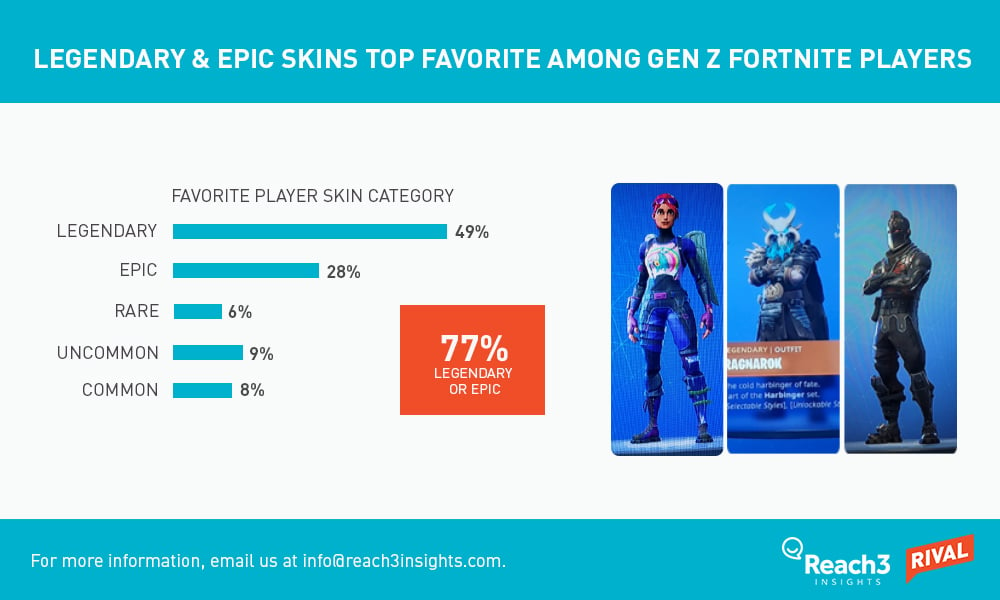Our study shows that there’s still much for companies to learn about Gen Z—the first true digital natives.
Just last week it was revealed that Epic Games, the company behind the popular game Fortnite, raised $1.25 billion in its latest funding round. If you’re wondering if there’s a typo in that last sentence, there isn’t: the company, according to a report from The Wall Street Journal, is now valued at nearly $15 billion.
Those numbers are stunning, but they are even more impressive if you consider that Fortnite is a free game. On most console, PC and mobile platforms, Fortnite Battle Royale—the multiplayer game where up to 100 players battle it out to become the last person, quad or duo standing—is available to download for free.
Despite the game being free, Epic Games makes millions of dollars per month. One study estimates that Epic Games brought in more than $1.2 billion between September 2017 and May 2018 alone. That number is likely significantly higher by now, following the game’s season 6 launch.
So how does Fortnite bring in the big bucks? It’s not just through ads. One way the game generates revenue is through Battle Pass, a system that rewards players throughout a season. Another way is through V-Bucks, Fortnite’s currency, which players can use to buy in-game virtual goods.
Skins, in particular, are popular among players. What’s interesting about skins is that they don’t give Fortnite players any type of advantage in the game. Skins are essentially just outfits or costumes. But players go nuts over skins, creating an underground market for Fortnite accounts.
In a recent study we conducted at Reach3 Insights, skins emerged as an interesting theme. Our study engaged more than 900 Gen Z players who talked to us about their attitudes, behaviors and expectations around Fortnite. We gathered feedback, videos and images from respondents using software from Rival Technologies, which provides a platform for chats and conversational surveys. (My colleague Leigh Admirand has more information about our methodology and approach.)
In my role at Reach3, I work frequently with multinational retail and consumer brands that want to better resonate with younger consumers. I believe that many of the insights my colleagues uncovered from this Fortnite study are useful to many of the clients I work with. I shared some notable takeaways below.
Expressing Their Personality and Achievements
People are obsessed with skins. Gen Z players, in fact, are willing to go out of their way to get a job or do chores to earn money they can use to buy skins. On average, the players we engaged with said they spend about $25 monthly to purchase skins.
In our chats, we asked players to send a photo of their favorite skins, revealing that the rarer skins are more popular.

It’s easy to assume that Legendary and Epic skins are on top because of how cool they look, but there’s more to this story. Sifting through qualitative responses, we discovered that a skin’s rarity is an instant visual cue signifying a player’s experience and skill. As players progress in Fortnite, they unlock new skins, so sporting something rare signifies someone’s expertise, longevity and experience in the game. Players with rare skins often get compliments from other gamers.
Perhaps more importantly, buying skins and cosmetics such as new character costumes or things like hats, tattoos and weapon appearances let players show their personality. Many players also pick their skins strategically to demonstrate their allegiance with friends and online competitors.
How does your brand’s products or services help consumers express their personality and achievements?
If you’re marketing to Gen Z, one question you should answer is this: How does your brand’s products or services help consumers express their personality and achievements? Fortnite demonstrates that Gen Z consumers aren’t necessarily looking for practical utility; skins, as I mentioned, don’t really provide a strategic advantage. Goods that showcase consumers’ identity in a fun way can be more compelling to these young consumers.
Creating a New Status Symbol
By letting players display their achievements, skins have become a status symbol in Fortnite. They let other players know whether you are good or bad, and how new you are to the game.
Gen Z’s appetite for skins isn’t really dissimilar to how previous generations, in their younger years, wanted specific fashion brands.
Much has been said already about Gen Z consumers wanting experiences over material things. Our study suggests that Gen Z still like owning stuff—but those things are different from what previous generations wanted. Gen Z’s appetite for skins isn’t really dissimilar to how previous generations, in their younger years, wanted specific fashion brands.
Apparel, fashion and other brands that develop physical products might want to explore opportunities to create digital versions of their offerings. Street brands such as Supreme, for instance, could partner with Epic Games and release a set of skins inspired by their real-world products. The opposite strategy is also possible: toy-maker Nerf, for example, is releasing a set of toy guns inspired by Fortnite.
Personalizing Their Looks
There are endless ways you can create your own unique look on Fortnite. My colleague Sean Campbell estimates that there are more than 8.2 billion possible skin combinations if you mix and match different outfits, pets, glider, axes, backpack, and trail.
In Fortnite, skins are a major way for people to personalize their own experience. This is important because more and more studies show that personalization is important for Gen Z consumers. One study from the National Retail Federation (NFR) found that 64% of Gen Z consumers agreed that a tailored price or service loyalty rewards were important to them.
Your company may not be able to offer 8.2 billion variations of your product, but look for ways to empower consumers to personalize their experience. Companies like Nike, Under Armour and Adidas, for instance, are using already technology to personalize their products.
Creating Something Worth Talking About
We were amazed at how many of the Fortnite skins are immediately recognizable to the gamers we engaged with. They were able to name skins almost immediately and tell us their value. Furthermore, we found that players learn about skins not only from checking them on the Fortnite store, but also through word of mouth. Players talk to other players about skins, which ones are cool, and why.
Do you really understand the motivations, attitudes and aspirations of your Gen Z audience?
The lesson here is simple: create products, services or experiences that drive word of mouth. Of course, this is easier said than done, but a deep understanding of your target audience is a good start. Do you really understand the motivations, attitudes and aspirations of your Gen Z audience? Unless you do your research and engage with these young consumers directly, you’re at risk of building products that miss the mark.
To Resonate with Gen Z, Engage With Them
Our study shows that there’s still much for companies to learn about Gen Z—the first true digital natives. Keeping your pulse on hot topics such as Fortnite can help uncover important insights. But more importantly, you also have to engage these young consumers directly to truly understand the factors driving trends.
If you’d like to learn more about our journey into the world of Fortnite, feel free to send me an email or say hi to us at Reach3 Insights.

Dara St. Louis
SVP & Founding Partner, Reach3 Insights







.webp?width=65&height=83&name=A-LIGN_HIPAA%20(1).webp)

